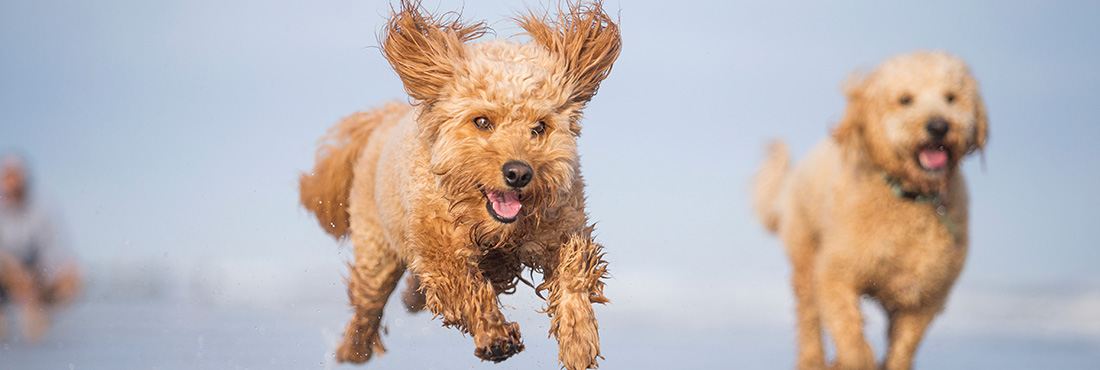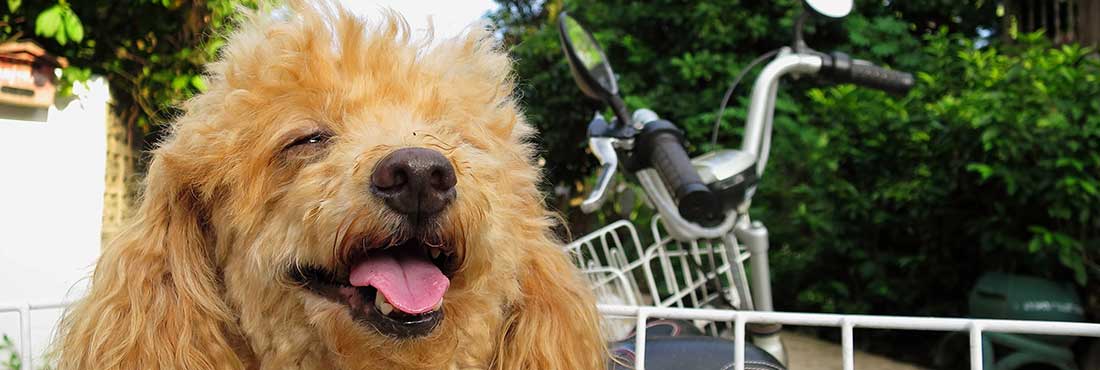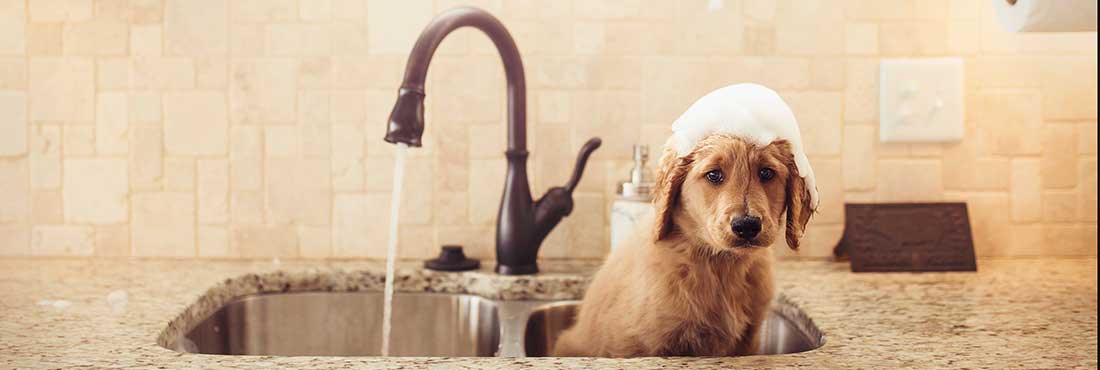When it comes to training a Goldendoodle puppy or adult dog, positive reinforcement is the best policy. Many new dog owners struggle to understand how and when to reward training during a training session, so we will cover all of that in this guide. From basic obedience training for your Goldendoodle to socializing with your other dogs when you add a new addition, this guide has all the tips and tricks you need.
Thankfully, the Goldendoodle is produced from two highly trainable dog breeds. Golden Retrievers, especially, are extremely easy to work with and pick up skills quickly. There may be some resistance while your pup is young and excitable, but all dogs can be trained. Keep reading to learn the best ways to start dog training with your Goldendoodle friend!
How to Train a Goldendoodle
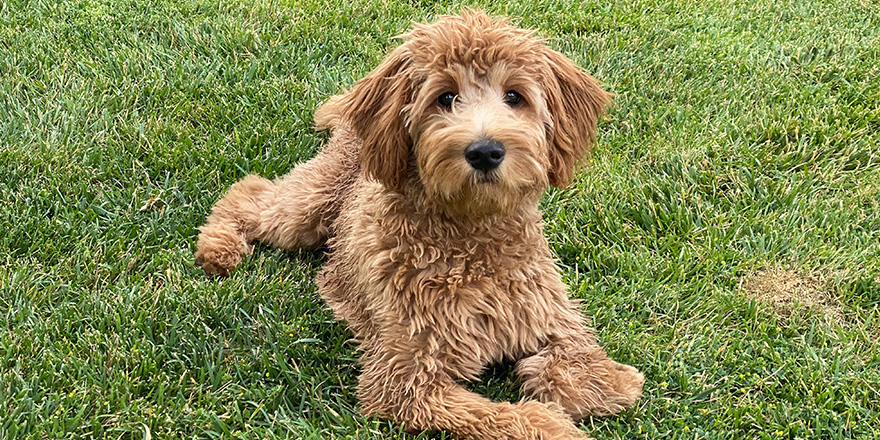
As a new dog owner, you won’t yet be used to the nuances of your little Goldendoodle friend. Goldendoodles come from breeding a Golden Retriever and a Poodle together, so you should expect them to have characteristics and traits from both these breeds.
Like all dogs, you should reward your Goldendoodle for good behavior. Professional dog trainers use various types of positive reinforcement during training sessions to ensure that their dogs associate their new skills with good things. For successful training, it’s crucial that you do the same.
Goldendoodles have some of the most wonderful qualities from both parent breeds. They’re intelligent, eager to please, and very trainable. When training your Goldendoodle, be sure not to overwork them. This can lead to frustration, and your pup may resist your training methods if it happens too frequently.
Introducing Your Goldendoodle to Another Dog
Also called “socialization”, this is a vital part of training your Goldendoodle, regardless of age. The process is the same for puppies and adult dogs of any breed.
Separate your new Goldendoodle from the other dog in your home. You should never try to immediately introduce two dogs, despite how cute some internet videos may seem. Employ the help of your family members to have each of you keeping an eye on a dog while you introduce them to each other over the course of a week.
The first step is to get each dog to eat with each other on the other side of a shut door. This is why it’s important to start with the dogs separated. You never know how either dog might react. To build up to this scenario, you should be switching a blanket, pillow, or toy from one dog’s room to the other dog’s room each day. These items will carry each dog’s scent, so they can learn how the other smells and become more familiar with them.
During this time, start moving their food bowls closer to the door each time they eat. Eventually, they will be eating together with a shut door between them. Only once they are successfully taking their meals this way should you attempt to let them eat together with the door open. Again, ask your family members for help during this step just in case something goes wrong. If your dogs are uncomfortable, shut the door and continue the process. You should be offering treats, calming words, and head rubs as incentives to each pet.
What Skills to Train Your Goldendoodle In
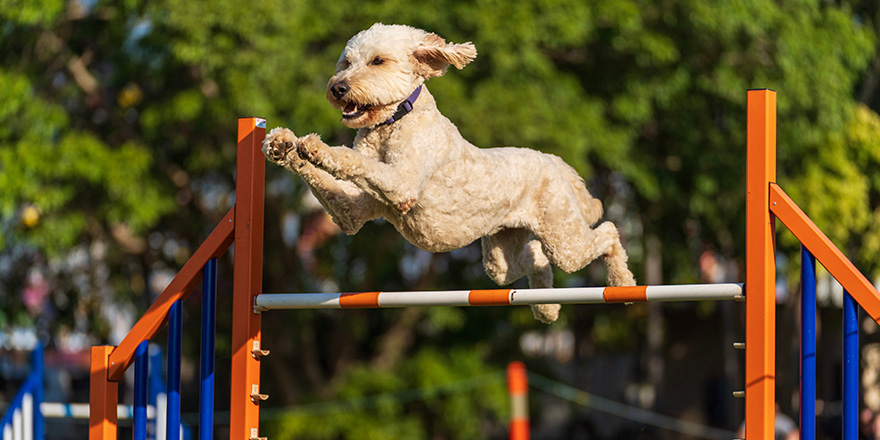
Dogs benefit from learning a range of skills. Thanks to a scrappy pup, not just tricks but everyday skills that they need so that your home isn’t a disaster. Here’s a list of skills and types of training that your Goldendoodle will benefit from:
- Potty training
- Leash/Harness training
- Crate training
- Socialization
- “Leave it” (verbal command used to get your dog to walk away from something, such as a small animal or an object)
- “Sit” (a verbal command that can help teach your dog patience)
- “Fetch” (a verbal command that is often used during playtime but has many other applications)
- “Down” (verbal command to get your dog to lie down, also helps teach your dog patience)
- “Stay” (verbal command to get your dog to stay put, even while you’re still moving)
- “Heel” (a verbal command that will bring your dog to your side and get them to stop what they’re doing)
- “Come” (verbal command to summon your dog)
- “Off” (verbal command to get your dog to move away or off of the thing they’re touching/on, such as the couch)
Commands such as “no” can be confusing for some dogs. Like children, dogs respond better when given something rather than just being told they can’t do something. What does “no” really mean to a dog, after all? You can use other commands in their place that will stop your dog from continuing any undesirable behavior. For example, if your dog is chasing a squirrel, command them to “leave it” rather than just shouting “no”. Shouting at your dog doesn’t get you anywhere, and excessive shouting may make them anxious or scared of you.
How to Train Your Goldendoodle in a Skill
No matter which skill you’re training these intelligent dogs, you’ll find that you can employ similar techniques during training sessions to keep things simple. Always be aware of your pup’s behavior while doing training. Puppy owners should know that their little friends aren’t going to have huge attention spans, so training sessions should be short. Long training sessions, even for adult dogs, can be boring and cause them to lose focus.
Pet owners should train one skill at a time. Yes, that sounds time-consuming, but the fact is that learning more than one skill at a time can confuse your pup. Now, you can potty train your dog while teaching them verbal commands. The same with any type of training versus verbal command. Young puppies will pick up training quickly but may still have accidents or get overexcited. Once potty trained, remember that they have small bladders, and you may occasionally clean up after them. Do not scold them, and don’t rub their face in it! Simply clean up to get rid of their scent, take them outside, and wait to see if they need to continue their business. If they do, offer them a treat and some positive reinforcement once they’re done.
Now, for verbal commands, training can be a bit more tedious. The best example your dog has is you, which means that you should be performing the trick for your dog to help them understand what you want them to do. A Goldendoodle pup doesn’t have anyone else to look to for help. You need to teach them just like their mother and siblings did while still with their litter.
For the “down” command, get down on the ground and position yourself similarly to your dog. This feels a bit awkward for humans because our limbs don’t bend like dogs’ legs. You should be curling your legs underneath you while your forearms are pressed against the floor. Repeat the command, offer your dog some head pats or a treat, and get back up. Then do it again.
What to Do if Your Dog isn’t Learning
If your dog seems to be struggling to pick up any new skills you’re trying to teach them, it’s time to contact professional dog trainers. Dog trainers use certain training tactics during sessions to get the best results from any new puppy in their class. They’ll have your dog in a sitting position in no time! But, the cool thing is that they’ll work with you and your dog together so that you can learn how to teach them effectively. The trainer will consider your behavior and watch how to interact with your dog, offering alternatives to help you bond with them better.
They can also teach you how playtime can be an effective learning tool. You wouldn’t think a chew toy would have any place in training time, but dog trainers often use toys to reward dogs and teach them new skills.
Before you start training with any professional, be sure to ask to visit so that you can see what the facilities are like or hire one who will come to you.
Dogs are social animals, and proper training will enable them to go to the dog park without causing you any concern while running around with other dogs.
Goldendoodle Training for Puppies
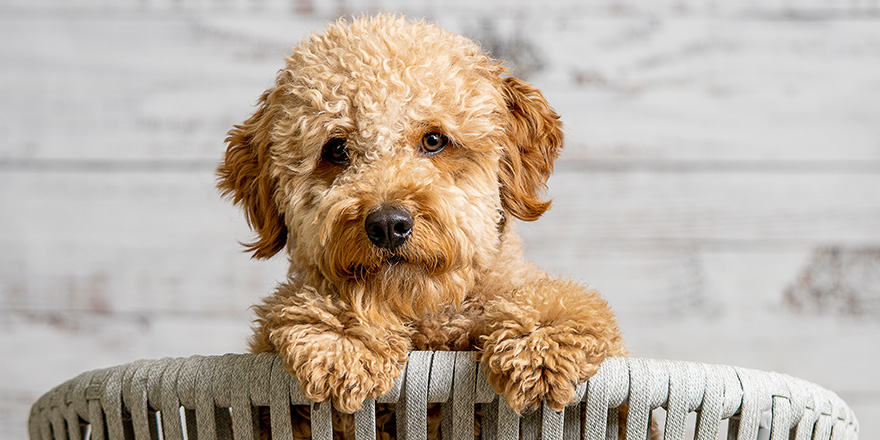
Trying to figure out how to train a Goldendoodle puppy? There’s not much difference between training a puppy and an adult dog, but puppies require more patience.
When you adopt an adult dog, the chances are they have already been trained in the most basic skills – potty training, perhaps a verbal command or two if you’re lucky. Some might even be leash trained (which helps prevent leash pulling during walks).
Puppies take a different kind of effort. They won’t know any skills or have any training. Their previous owner may have started potty training them, but the training isn’t likely to be complete. Your puppy may understand the basic principles of when it’s appropriate to go to the bathroom, but it might be best to install a litterbox for a little while until you’re sure they won’t use your rug as a toilet.
How to Potty Train a Goldendoodle Puppy
Training a Goldendoodle puppy to effectively empty their bladder and bowels is a task that no one enjoys. While young, house training a puppy often means cleaning up after them more than anyone can admit.
Sticking to a schedule is the best thing you can do for a puppy of a young age. Having a bathroom schedule for them helps them get used to only being let out a few times a day, which can train their body’s toilet needs. Puppies need the bathroom often, so you’ll find yourself going out less frequently as they age.
Several times a day, take your puppy outside after they eat or drink and wait for them to do their business. After they’ve finished, reward them and bring them back inside.
This tells your puppy that you’re happy with them for using the outside world as a bathroom. When they pee or poop indoors and don’t get any reward, they will realize where it’s appropriate to use the bathroom.
Young puppies will need to be taken outside a lot, so schedule a time to take them after each meal.
How to Train a Goldendoodle Puppy Not to Bite
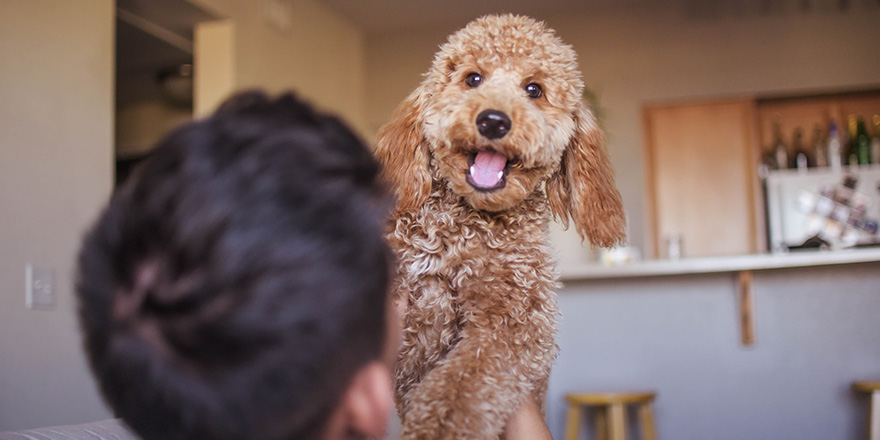
Your puppy should have learned a little about their bite strength with their littermates. It’s common for puppy litter to munch on each other during playtime, and they rely on their litter to tell them when they’re biting too hard. They do this by yelping or whimpering to let the offending dog know that the bite was too much for play.
Your puppy will likely come to you still learning about biting. Now that they’re getting older, it’s time to teach them when it’s appropriate to bite.
When teaching your puppy that it’s not okay to bite, stick to one command. “No biting” is good because it doesn’t sound like any other command and won’t confuse them. When your puppy nips your skin, firmly tell them “no biting” and move away. The less attention you give them after biting, the better because this tells them it wasn’t a good thing to do. Be consistent. Don’t tell your puppy “no biting” and then allow them to nip at you or other family members. Be sure to tell anyone to repeat the command when visiting if the puppy nips them.
Frequently Asked Questions
Likely, your Goldendoodle isn't hard to train, you may just not have the right techniques. Goldendoodles take to training very well, but they can struggle if they aren't being given the right kind of training. Be sure to offer positive reinforcement throughout training sessions and shorten sessions if your dog stops responding to them. If nothing seems to help, consider hiring a dog trainer to get you back on track.
It usually takes four to six months to potty train any dog, but it can take up to a year, depending on various factors. This includes the size of your dog, their breed, any medical conditions, and their history. Be patient with your dog and seek veterinary advice if you feel something isn't quite right or your dog is using the bathroom very often.
Crate training is a great way to offer a safe place to your dog when they're feeling stressed, but it's not always an immediate solution. Familiarize yourself with signs of canine stress and anxiety and research some of the best ways to be there for your dog when they're feeling overwhelmed. Exercising often can help, as can petting and just sitting with your dog when they're stressed out.
Definitely! Crate training any dog is a great idea because it gives your dog somewhere they can go to, which is entirely their own. Think about it - we humans have our rooms, but our dogs don't have a room. Create a safe space for your dog in your home, including their toys, a comfortable crate, and food and water.
Goldendoodles can be high maintenance because of their coat type. In a generalized way, they're nice dogs to own, but their coat will mean that you must schedule semi-frequent visits to a groomer. As well as that, Goldendoodles are known for having a few common health issues that affect their joints and eyes, so that's something you'll need to watch out for.
When your dog jumps up next to you, pay them no attention. Turn your back or walk away entirely. These actions show your back that you're not interested in their behavior, and they'll eventually stop jumping up to sit or lie down next to you. Do not pet your dog while trying to reinforce this behavior. As tempting as it is to pet them or give them love, you'll only be telling them that you're okay with their actions.

